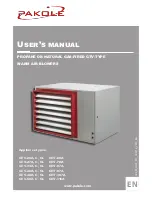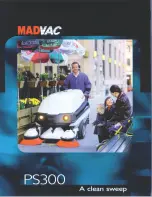
6
7
●
Switch off the engine when resting and when leaving the mist blower unattended.
Place it in a safe location to prevent danger to others, setting fire to combustible
materials, or damage to the machine (8).
●
Never lay the hot mist blower onto dry grass or onto any combustible materials.
●
Do not place the mist blower on the ground when operating at high speed, because
small objects such as sand, grass, dust, etc. may be pulled into the air intake and
damage the fan wheel.
●
During work breaks, do not leave the mist blower in the hot direct sunlight or near
any heat source.
●
All protective parts and guards supplied with the machine must be used during
operation.
●
Never operate the engine with a faulty exhaust muffler.
●
Do not put your hand into exhaust vent. The muffler become very hot during
operation, and may cause burns.
●
Do not touch engine cover for long time. It may become hot during operation and
may cause burns.
●
Shut off the engine during transport (8).
●
Position the mist blower safely during car or truck transportation to avoid fuel
leakage.
●
When transporting the mist blower, ensure that the fuel tank and liquid/chemical
container are completely empty.
Refueling
●
Shut off the engine (8) during refueling, keep well away from open flame (9) and
do not smoke.
●
Avoid skin contact with petroleum products. Do not inhale fuel vapor.
Always wear protective gloves during refueling. Change and clean protective
clothing at regular intervals.
●
Take care not to spill either fuel or oil in order to prevent soil contamination
(environmental protection). Clean the mist blower immediately after fuel has been
spilled. Allow wet cloths to dry before disposing in properly, covered container to
prevent spontaneous combustion.
●
Avoid any fuel contact with your clothing. Change your clothing immediately if fuel
has been spilled on it (fire hazard).
●
Inspect the fuel tank cap at regular intervals making sure that it stays securely
fastened.
●
Carefully tighten the locking screw of the fuel tank. Change locations to start the
engine (at least 3 meters (10 feet) away from the place of refueling) (10).
●
Never refuel in closed rooms. Fuel vapors accumulate at ground level (risk of
explosions)
●
Only transport and store fuel in approved containers. Make sure stored fuel is not
accessible to children.
●
Do not attempt to refuel a hot or a running engine.
Method of operation
●
Use the mist blower only in good light and visibility. During cold seasons beware of
slippery or wet areas, ice and snow (risk of slipping).
Always ensure a safe footing (11).
●
Never work on unstable surfaces or steep terrain (11).
●
If you are unfamiliar with the risks associated with the particular chemical you use,
review the product label and/or material safety data sheet for that substance and/
or consult the material manufacturer/supplier.
You may also ask your employer, governmental agencies and other sources for
information on hazardous materials.
Some other authorities have published lists of substances known to cause cancer,
reproductive toxicity, etc. (11).
●
To reduce the risk of personal injury, do not direct air blast towards bystanders,
since the high pressure of the air flow could injure eyes and could blow small
objects at great speed (12).
●
Never spray in the direction of humans, animals or property which might be injured
or damaged by spraying (12).
●
Never insert any foreign object into the air intake of the machine or into the nozzle
of the mist blower. It will damage the fan wheel and may cause serious injury to
the operator or bystanders as a result of the object or broken parts being thrown
out at high speed.
●
Pay attention to the direction of the wind, i.e., do not work against the wind.
●
To reduce the risk of stumbling and loss of control, do not walk backward while
operating the machine.
●
Always shut off the engine before cleaning or servicing the unit or replacing parts.
●
Take a rest to prevent loss of control caused by fatigue. We recommend to take a
10 to 20-minute rest every hour.
(8)
(9)
(10)
3 m (10 ft)
(11)
(12)
Summary of Contents for SP-7650.4 R
Page 262: ...262 ...
Page 263: ...263 ...








































